Manual, Continuous Rotation Mounts
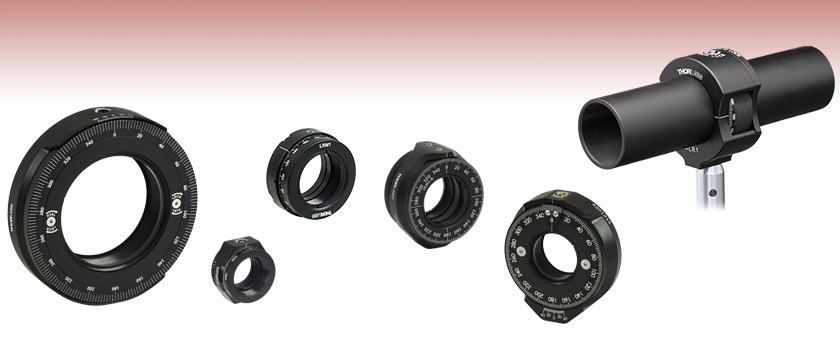
- Lockable Rotation Mounts for Ø1/2", Ø1", and Ø2" Optics
- All Models Offer 360° Rotation
- SM-Threaded Optic Bores
RSP2D
Ø2" Rotation Mount with Adjustable Zero
MRM05
Ø1/2" Mini-Series Rotation Mount
DLM1
Ø1" Dual Rotation Mount
RSP1X15
Indexing Rotation Mount for Discrete 15° Rotation
Application Idea
CLR1 Rotation Mount Lets Optic Rotate While Both Lens Tubes Remain Fixed (All Sold Separately)
LRM1
Ø1" Rotation Mount, External SM1 Threads

Please Wait
Features
- Rotation Mounts with 360° Continuous Rotation
- Rotational Position Lockable via Setscrew
- Full 360° Engraved Scale Marked in 2° Increments
- For Mounting Options, See Table Below
Thorlabs offers a diverse line of continuous rotation mounts to accommodate a variety of optic sizes and applications. These mounts provide smooth, backlash-free rotation in compact, lockable packages. To mount an optic, simply place it within the central SM-threaded bore and secure it using a spanner wrench with the included retaining ring. Rotation mounts are available for Ø1/2", Ø1", and Ø2" optics. An easy-to-read radial scale offers 2° graduation marks, labeled every 20°, for precise incremental movement and repeatable positioning.
Standard rotation mounts, including the MRM05(/M), RSP05(/M), RSP1(/M), and RSP2(/M) are post mountable, and feature a locking screw to fix the rotational position. The MRM05(/M) and RSP05(/M) rotation mounts hold Ø1/2" optics, and the MRM05(/M) can be used with our Mini-Series Optical Assemblies. The RSP1D(/M) and RSP2D(/M) rotation mounts hold Ø1" or Ø2" optics, respectively, and offer similar functionality to our standard rotation mounts with the added feature of a rotatable dial: the front dial face can be rotated separately from the optic cell and then locked down. This allows the engraved scale to be aligned with an axis of the optic, such as the fast axis of a wave plate.
The CRM05 and LRM1 rotation mounts hold Ø1/2" or Ø1" optics, respectively, and feature external SM1 (1.035"-40) threads for integrating optics into SM1 lens tube or 30 mm cage cube systems. The front dial face rotates the optic inside the mount, but the external SM1 threads are fixed.
The CLR1(/M) rotation mount is designed to orient rotationally sensitive Ø1" optics within SM1 lens tube systems. Round cylindrical lenses, wave plates, and other polarization optics are commonly used with this mount. Unlike our other rotation mounts, the CLR1(/M) allows for lens tubes to be attached to either end and remain stationary as the mounted optic is rotated.
For applications that require rotation in discrete increments, we offer the RSP1X15(/M) and RSP1X225(/M) mounts for Ø1" optics. These mounts have a top-located setscrew [5/64" (2.0 mm) hex] that, when loosened, allows for continuous 360° motion. With the setscrew tightened, the mount can be rotated through a number of indexed positions in discrete increments.
The DLM1(/M) dual rotation mount features two independently rotating optic carriages that allow two optics to be mounted in close proximity. The carriages are magnetically attached to the main body of the mount so that they can be removed and replaced as needed. Extra optic carriages are available separately.
Thorlabs also offers rotation mounts that are compatible with our 16 mm, 30 mm, and 60 mm cage systems. For demanding applications, we offer high-resolution, micrometer-driven rotation mounts providing roughly 2.4 arcmin per micrometer division. Please see the Rotation Mounts and Stages tab for our entire selection of rotation mounts and stages.
| Quick Links | |||||||||||
|---|---|---|---|---|---|---|---|---|---|---|---|
| Product Image (Click to Enlarge) |
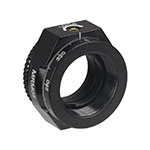 |
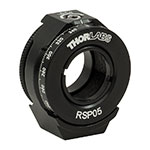 |
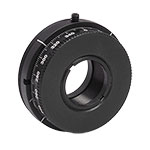 |
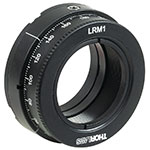 |
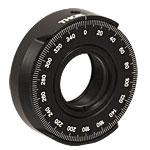 |
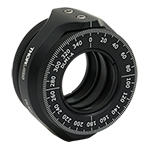 |
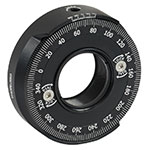 |
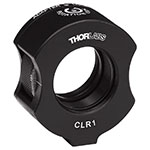 |
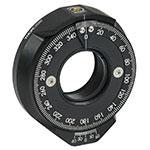 |
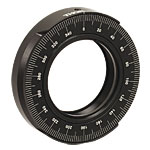 |
 |
| Item # | MRM05(/M) | RSP05(/M) | CRM05 | LRM1 | RSP1(/M) | DLM1(/M) | RSP1D(/M) | CLR1(/M) | RSP1X15(/M) RSP1X225(/M) |
RSP2(/M) | RSP2D(/M) |
| Optic Size | Ø1/2" | Ø1" | Ø2" | ||||||||
| Internal Threading | SM05 (0.535"-40) | SM1 (1.035"-40) | SM2 (2.035"-40) | ||||||||
| Additional Features |
- | External SM1 (1.035"-40) Threads | - | Two Independently Rotating Carriages | Adjustable Zero | Rotates Optic Within Fixed Lens Tube System | Continuous 360° or Indexed Rotation | - | Adjustable Zero | ||
| Post Mounting | 4-40 (M3) Stud |
8-32 (M4) Tap | None | 8-32 (M4) Tap | |||||||
| SM05 Threading: Ø1/2" Lens Tubes, 16 mm Cage Systems | |||
|---|---|---|---|
| External Thread, 0.535"-40.0 UNS-2A | Internal Thread, 0.535"-40.0 UNS-2B | ||
| Max Major Diameter | 0.5340" | Min Major Diameter | 0.5350" |
| Min Major Diameter | 0.5289" | Min Pitch Diameter | 0.5188" |
| Max Pitch Diameter | 0.5178" | Max Pitch Diameter | 0.5230" |
| Min Pitch Diameter | 0.5146" | Min Minor Diameter (and 83.3% of Thread) | 0.508" |
| Max Minor Diameter | 0.5069" | Max Minor Diameter (and 64.9% of Thread) | 0.514" |
| RMS Threading: Objective, Scan, and Tube Lenses | |||
|---|---|---|---|
| External Thread, 0.800"-36.0 UNS-2A | Internal Thread, 0.800"-36.0 UNS-2B | ||
| Max Major Diameter | 0.7989" | Min Major Diameter | 0.8000" |
| Min Major Diameter | 0.7934" | Min Pitch Diameter | 0.7820" |
| Max Pitch Diameter | 0.7809" | Max Pitch Diameter | 0.7866" |
| Min Pitch Diameter | 0.7774" | Min Minor Diameter (and 83.3% of Thread) | 0.770" |
| Max Minor Diameter | 0.7688" | Max Minor Diameter (and 64.9% of Thread) | 0.777" |
| C-Mount Threading: Machine Vision Lenses, CCD/CMOS Cameras | |||
|---|---|---|---|
| External Thread, 1.000"-32.0 UN-2A | Internal Thread, 1.000"-32.0 UN-2B | ||
| Max Major Diameter | 0.9989" | Min Major Diameter | 1.0000" |
| Min Major Diameter | 0.9929" | Min Pitch Diameter | 0.9797" |
| Max Pitch Diameter | 0.9786" | Max Pitch Diameter | 0.9846" |
| Min Pitch Diameter | 0.9748" | Min Minor Diameter (and 83.3% of Thread) | 0.966" |
| Max Minor Diameter | 0.9651" | Max Minor Diameter (and 64.9% of Thread) | 0.974" |
| SM1 Threading: Ø1" Lens Tubes, 30 mm Cage Systems | |||
|---|---|---|---|
| External Thread, 1.035"-40.0 UNS-2A | Internal Thread, 1.035"-40.0 UNS-2B | ||
| Max Major Diameter | 1.0339" | Min Major Diameter | 1.0350" |
| Min Major Diameter | 1.0288" | Min Pitch Diameter | 1.0188" |
| Max Pitch Diameter | 1.0177" | Max Pitch Diameter | 1.0234" |
| Min Pitch Diameter | 1.0142" | Min Minor Diameter (and 83.3% of Thread) | 1.008" |
| Max Minor Diameter | 1.0068" | Max Minor Diameter (and 64.9% of Thread) | 1.014" |
| SM30 Threading: Ø30 mm Lens Tubes | |||
|---|---|---|---|
| External Thread, M30.5 x 0.5 – 6H/6g | Internal Thread, M30.5 x 0.5 – 6H/6g | ||
| Max Major Diameter | 30.480 mm | Min Major Diameter | 30.500 mm |
| Min Major Diameter | 30.371 mm | Min Pitch Diameter | 30.175 mm |
| Max Pitch Diameter | 30.155 mm | Max Pitch Diameter | 30.302 mm |
| Min Pitch Diameter | 30.059 mm | Min Minor Diameter (and 83.3% of Thread) | 29.959 mm |
| Max Minor Diameter | 29.938 mm | Max Minor Diameter (and 64.9% of Thread) | 30.094 mm |
| SM1.5 Threading: Ø1.5" Lens Tubes | |||
|---|---|---|---|
| External Thread, 1.535"-40 UNS-2A | Internal Thread, 1.535"-40 UNS-2B | ||
| Max Major Diameter | 1.5339" | Min Major Diameter | 1.535" |
| Min Major Diameter | 1.5288" | Min Pitch Diameter | 1.5188" |
| Max Pitch Diameter | 1.5177" | Max Pitch Diameter | 1.5236" |
| Min Pitch Diameter | 1.5140" | Min Minor Diameter (and 83.3% of Thread) | 1.508" |
| Max Minor Diameter | 1.5068" | Max Minor Diameter (and 64.9% of Thread) | 1.514" |
| SM2 Threading: Ø2" Lens Tubes, 60 mm Cage Systems | |||
|---|---|---|---|
| External Thread, 2.035"-40.0 UNS-2A | Internal Thread, 2.035"-40.0 UNS-2B | ||
| Max Major Diameter | 2.0338" | Min Major Diameter | 2.0350" |
| Min Major Diameter | 2.0287" | Min Pitch Diameter | 2.0188" |
| Max Pitch Diameter | 2.0176" | Max Pitch Diameter | 2.0239" |
| Min Pitch Diameter | 2.0137" | Min Minor Diameter (and 83.3% of Thread) | 2.008" |
| Max Minor Diameter | 2.0067" | Max Minor Diameter (and 64.9% of Thread) | 2.014" |
| SM3 Threading: Ø3" Lens Tubes | |||
|---|---|---|---|
| External Thread, 3.035"-40.0 UNS-2A | Internal Thread, 3.035"-40.0 UNS-2B | ||
| Max Major Diameter | 3.0337" | Min Major Diameter | 3.0350" |
| Min Major Diameter | 3.0286" | Min Pitch Diameter | 3.0188" |
| Max Pitch Diameter | 3.0175" | Max Pitch Diameter | 3.0242" |
| Min Pitch Diameter | 3.0133" | Min Minor Diameter (and 83.3% of Thread) | 3.008" |
| Max Minor Diameter | 3.0066" | Max Minor Diameter (and 64.9% of Thread) | 3.014" |
| SM4 Threading: Ø4" Lens Tubes | |||
|---|---|---|---|
| External Thread, 4.035"-40 UNS-2A | Internal Thread, 4.035"-40.0 UNS-2B | ||
| Max Major Diameter | 4.0337" | Min Major Diameter | 4.0350" |
| Min Major Diameter | 4.0286" | Min Pitch Diameter | 4.0188" |
| Max Pitch Diameter | 4.0175" | Max Pitch Diameter | 4.0245" |
| Min Pitch Diameter | 4.0131" | Min Minor Diameter (and 83.3% of Thread) | 4.008" |
| Max Minor Diameter | 4.0066" | Max Minor Diameter (and 64.9% of Thread) | 4.014" |
Reading a Vernier Scale on a Linear Main Scale
Vernier scales are typically used to add precision to standard, evenly divided scales (such as the scales on Thorlabs' rotation, goniometric, or translation mounts). A vernier scale has found common use in many precision measurement instruments, the most common being calipers and micrometers. The vernier scale uses two scales side-by-side: the main scale and the vernier scale. The direct vernier scale has a slightly smaller spacing between its tick marks owing to the vernier scale having N ticks for every N - 1 ticks on the main scale. Hence, the lines on the main scale will not line up with all the lines on the vernier scale. Only one line from the vernier scale will match well with one line of the main scale, and that is the trick to reading a vernier scale.
Figures 1 through 3 show a linear vernier scale system for three different situations. In each case, the scale on the left is the main scale, while the small scale on the right is the vernier scale. When reading a vernier scale, the main scale is used for the gross number, and the vernier scale gives the precision value. In this manner, a standard ruler or micrometer can become a precision instrument.
The 0 on the vernier scale is the "pointer" (marked by a red arrow in Figures 1 - 5) and will indicate the main scale reading. In Figure 1 we see the pointer is lined up directly with the 75.6 line. Notice that the only other vernier scale tick mark that lines up well with the main scale is 10. Since the pointer lines up with the main scale’s 75.6, the reading from Figure 1 is 75.60 (in whatever units the instrument measures).
That is essentially all there is to reading a vernier scale. It's a very straightforward way of increasing the precision of a measurement instrument. To expound, let’s look at Figure 2. Here we see that the pointer is no longer aligned with a line on the main scale, but instead it is slightly above 75.6 and below 75.7; thus, the gross measurement is 75.6. The first vernier line that coincides with a main scale line is the 5, shown with a blue arrow. The vernier scale gives the final digit of precision; since the 5 is aligned to the main scale, the precision measurement for Figure 2 is 75.65.
Since this vernier scale is 10% smaller than the main scale, moving the vernier scale by 1/10 of the main scale will align the next vernier marking. This asks the obvious question: what if the measurement is within the 1/10 precision of the vernier scale? Figure 3 shows just this. Again, the pointer line is in between 75.6 and 75.7, yielding the gross measurement of 75.6. If we look closely, we see that the vernier scale 7 (marked with a blue arrow) is very closely aligned to the main scale, giving a precision measurement of 75.67. However, the vernier scale 7 is very slightly above the main scale mark, and we can see that the vernier scale 8 (directly above 7) is slightly below its corresponding main scale mark. Hence, the scale on Figure 3 could be read as 75.673 ± 0.002. A reading error of about 0.002 would be appropriate for
this instrument.
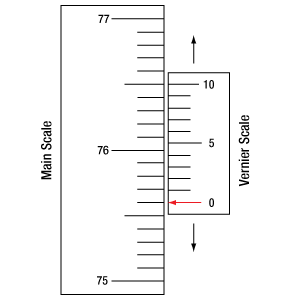
Click to Enlarge
Figure 1: An example of how to read a vernier scale. The red arrow indicates what is known as the pointer. Since the tick mark labeled 10 on the vernier scale aligns with one of the tick marks on the main scale, this vernier scale is reading 75.60 (in whatever units the instrument measures).
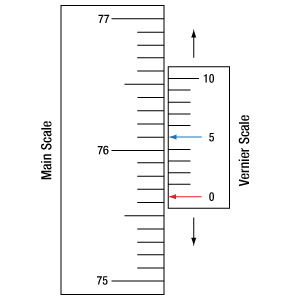
Click to Enlarge
Figure 2: The red arrow indicates the pointer and the blue arrow indicates the vernier line that matches the main scale. This scale reads 75.65.
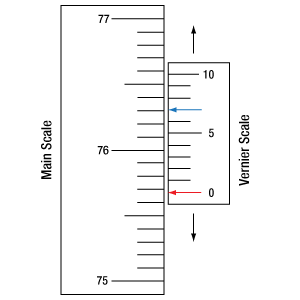
Click to Enlarge
Figure 3: The red arrow indicates the pointer, and the blue arrow indicates the vernier line that matches the main scale. This scale reads 75.67 but can be accurately read as
75.673 ± 0.002.
Reading a Vernier Scale on a Rotating Main Scale
The vernier scale may also be used on rotating scales where the main scale and vernier scale do not share units. Figures 4 and 5 show a vernier scale system for two different situations where the main scale is given in degrees and the vernier scale has ticks every 5 arcmin (60 arcmin = 1°). In each case, the scale on the top is the main scale, while the small scale on the bottom is the vernier scale.
In Figure 4 we see the pointer is lined up directly with the 341° line. Notice that the only other vernier scale tick marks that line up well with the main scale are ±60 arcmin. Since the pointer lines up with the main scale at 341°, the reading from Figure 4 is 341.00°.
There are two ways to determine the reading if the zero on the vernier scale line is between two lines of the main scale. For the first method, take the line on the left side of the pointer on the vernier scale and subtract that value (in arcmin) from the value on the main scale that is to the right on the main scale. As an example, in Figure 5 the vernier pointer is between 342° and 343°; using the left blue arrow of the vernier scale results in
As we've seen here, vernier scales add precision to a standard scale measurement. While it takes a bit of getting used to, with a little practice, reading these scales is fairly straightforward. Vernier scales, whether they are direct or retrograde*, are read in the same fashion.
*A retrograde vernier scale has a larger spacing between its tick marks with N ticks for every N + 1 ticks on the main scale.
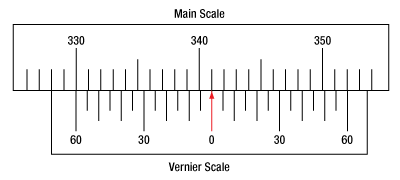
Click to Enlarge
Figure 4: An example of a vernier scale where the main scale and the vernier scale are in different units (degrees and arcmins, respectively). The red arrow indicates the pointer. This scale reads 341.00°.
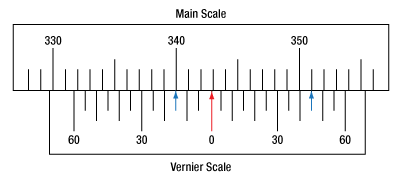
Click to Enlarge
Figure 5: The red arrow indicates the pointer and the blue arrows give the precision value from the vernier scale.
This scale reads 342.75°.
| Posted Comments: | |
Kamrul Ome
(posted 2024-08-15 16:56:11.59) Until someone picks up one of these pieces and tries it themselves, it is difficult to understand that the wave plate holders are magnetically attached to the mount. To put a wave plate in there, one needs to use a retainer ring. Moreover, one should clarify whether there is any preferred orientation for the wave plate holders. These aspects can easily be clearly described in a manual, which I believe would make these sorts of devices more popular. The reader may think that these are small details and unimportant, but any competent physicist knows that small details matter at the end of the day. Many people don't get this, but clarity and rigor prevail over everything. Thanks. cdolbashian
(posted 2024-08-26 09:26:13.0) Thank you for reaching out to us with this inquiry. Much of the information you are searching for can be found directly on the product page in the product description. I have contacted you directly to discuss your inquiries and show you where to find similar types of information in the future. user
(posted 2024-08-15 07:46:11.09) Since LRM1 has both an internal and an external thread I was wondering if I can combine two of them to mount and rotate two separate waveplates independently from each other? As in mounting each waveplate in one of the mounts, then screwing the two mounts into each other and then still being able to rotate each plate independently?
Thanks a lot in advance cdolbashian
(posted 2024-08-26 08:37:55.0) Thank you for reaching out to us with this inquiry. While this is technically feasible to do, you may run into some difficulties when rotating one with respect to the other, as they are threaded into each other's rotation element. Because of this, you might have some trouble explicitly rotating just one, while holding the other stationary. I have reached out to you with a few alternate part suggestions in order to achieve the result you described. Aleksej Majkic
(posted 2023-01-26 10:26:58.213) We have a RSP1X15/M rotation mount, which is very tight (it needs considerable torque to rotate it).
Is there a recomended procedure to remedy this?
Like dismantling&oiling it, or just oiling it?
Thank you. jdelia
(posted 2023-02-02 08:55:26.0) Thank you for contacting Thorlabs. You are welcome to try using some grease/oil to get a smoother rotation, however we do not recommend dismantling the mount. It is also important to make sure that the screw at the top of the mount is disengaged. I have reached out to you directly to troubleshoot this with you and discuss your application further. user
(posted 2022-03-02 02:16:11.153) It looks like our optic is rotating around a different axis than it's center. Do you have an estimate on the variance of the distance from the rotation axis and the center of the thread? Maybe this particular mount is a outlier, so I would like to know if that is the case and if replacing it would solve the problem. jdelia
(posted 2022-03-11 08:04:33.0) Thank you for contacting Thorlabs. I have contacted you directly to discuss your application. user
(posted 2021-11-09 12:15:01.383) Dear madam or sir, are there any items like MRM05 but have a countersunk hole in alignment key or a magnetic base? Thanks! YLohia
(posted 2021-12-23 11:36:39.0) Thank you for contacting Thorlabs. What are you referring to when you say "alignment key"? Could you please provide a diagram to illustrate exactly what you're looking for? I have reached out to you directly to discuss this further. Anitta Rose Thomas
(posted 2020-01-15 10:59:12.483) Is there any M4 tapped hole in LRM1.?
Looking forward
Thanks
Anitta YLohia
(posted 2020-01-15 08:42:26.0) Hello Anitta, thank you for contacting Thorlabs. The LRM1 mount is specifically designed to be mounted to other optic mounts/tubes featuring SM1 threads. You may use the LRM1 along with our LMR1/M to get the ability to mount with an M4 tap. We also offer the RSP1/M, which is similar to the LRM1 but is designed with an M4 tapped hole for mounting. Markus G
(posted 2019-06-11 12:53:18.293) Is there a specification for tip/tilt of a mounted element during a 360° rotation? I would be especially interested to get specs for the mounts RSP1/M and RSP1X15/M. YLohia
(posted 2019-06-28 02:45:46.0) Hello, thank you for contacting Thorlabs. Based on our testing, we expect the typical wobble to be the following over a full 360 degree rotation range:
RSP1 – 50 µrad
RSP1X15 – 300 µrad
RSP1X15 (with indexing rotation engaged) - 500 µrad user
(posted 2019-05-07 08:04:24.55) does not have enough thread to lock into a CCM beamsplitter consistently - instead it goes past the thread and just spins llamb
(posted 2019-05-08 01:14:20.0) Thank you for your feedback. The LRM1 features the same 3 mm long external SM1 thread as our standard SM1 lens tubes. I see you did not leave contact information, so please reach out to your local Thorlabs Tech Support team (techsupport.uk@thorlabs.com) with further details to clarify what exactly is spinning. cottsb
(posted 2018-11-27 15:43:59.67) Is it possible to reindex the mount after mounting a polarizer or other optic. That is using a transmission measurement through a mounted optic to find the precise V or H position and reindexing that to zero on the mount? YLohia
(posted 2018-11-28 08:39:00.0) Unfortunately, the RSP1 cannot be reindexed. To adjust the zero position, we recommend the RSP1D mount. lrotter
(posted 2018-08-08 17:52:58.373) What is the indexing angle repeatability for RSP1X__? llamb
(posted 2018-08-16 04:49:17.0) Thank you for contacting Thorlabs. The indexing angle repeatability is at worst ±0.5°, which is the angular tolerance for the v-grooves contained in the indexing ring. syim
(posted 2018-04-12 00:06:27.89) Could you make "RSP1D/M" without retaining lip? I hope to connect another SM1 threaded mount on the back side. Thank you. llamb
(posted 2018-04-12 08:17:56.0) Hello, thank you for contacting Thorlabs. We may be able to offer a custom rotation mount without the retaining lip. We will reach out to you directly to discuss a quote and our custom capabilities. user
(posted 2017-11-17 00:49:03.503) I'd love to buy a simple rotation mount (like RSP05, RSP1, or RSP2) for 1.5 inch optics. nbayconich
(posted 2017-12-18 03:41:31.0) Thank you for your feedback. We are happy to here suggestions from our customers on how to improve our variety of products. As an alternative solution a Ø1.5" optic can be mounted to a Ø2" rotational mount like RSP2 by using the SM2AD1.5 adapter for Ø1.5" optics. I will reach out to you directly to discuss our custom capabilities.
https://www.thorlabs.com/thorproduct.cfm?partnumber=SM2AD1.5 marinaphotonics
(posted 2016-08-08 10:41:39.05) I have 150 3" wedges and need to put them together in pairs. What would it take to get the RSP2D or similar up to 3" nday
(posted 2015-11-16 15:12:35.897) I'll likely go with a non-indexing version, but I'd love to see a 30mm cage version of the Indexing Rotation Mounts for Ø1" Optics, RSP1X15 and RSP1x225 and their metric versions. (My specific project would use a RSP1X15.)
Great equipment, and I really appreciate how responsive Thorlabs is to customer questions. Thank you! besembeson
(posted 2015-11-19 10:09:50.0) Response from Bweh at Thorlabs USA: Thanks for your kind words and thanks for the suggestion. We will review this and I will follow up with you to know more about your application. For now we only have 30mm cage-system compatible continuous rotation mounts: http://www.thorlabs.com/newgrouppage9.cfm?objectgroup_id=1885&pn=CRM1 user
(posted 2013-03-27 12:16:01.643) Do you have a Continuous Rotation Mount for Ø1/2" Optics directly mountable on SM1 thread? cdaly
(posted 2013-04-03 16:12:00.0) Response from Chris at Thorlabs: Thank you for using our web feedback. No we do not have a rotation mount exactly like this, but the CLR1 can be mounted onto an SM1 thread and a half inch optic rotated continuously within using an adapter like SM1A6(T) or AD1. olsonaj
(posted 2013-03-17 13:54:58.173) do you have a rotation mount that could accommodate a 30mm diameter waveplate? Perhaps with an adapter of some type? jlow
(posted 2013-03-18 13:35:00.0) Response from Jeremy at Thorlabs: We do not have a 30mm rotation mount. However, we do have the RSP2 which you can use with a SM2A11 adapter and SM30L05 to mount a Ø30mm optic. technicalmarketing
(posted 2007-08-16 10:41:30.0) Wave plate and polarizer links have been added to the related items tab. Thank you for the suggestion. acable
(posted 2007-08-15 00:09:19.0) Waveplates and polarizers are the most used optical elements that require a rotation stage, please consider adding to the "Related Item" tab. |
Rotation Mount and Stage Selection Guide
Thorlabs offers a wide variety of manual and motorized rotation mounts and stages. Rotation mounts are designed with an inner bore to mount a Ø1/2", Ø1", or Ø2" optic, while rotation stages are designed with mounting taps to attach a variety of components or systems. Motorized options are powered by a DC Servo motor, 2 phase stepper motor, piezo inertia motor, or an Elliptec™ resonant piezo motor. Each offers 360° of continuous rotation.
Manual Rotation Mounts
| Rotation Mounts for Ø1/2" Optics | |||||||
|---|---|---|---|---|---|---|---|
| Item # | MRM05(/M) | RSP05(/M) | CRM05 | PRM05(/M)a | SRM05 | KS05RS | CT104 |
| Click Photo to Enlarge |
 |
 |
 |
 |
 |
 |
 |
| Features | Mini Series | Standard | External SM1 (1.035"-40) Threads |
Micrometer | 16 mm Cage-Compatible | ±4° Kinematic Tip/Tilt Adjustment Plus Rotation | Compatible with 30 mm Cage Translation Stages and 1/4" Translation Stagesb |
| Additional Details | |||||||
| Rotation Mounts for Ø1" Optics | ||||||||
|---|---|---|---|---|---|---|---|---|
| Item # | RSP1(/M) | LRM1 | RSP1D(/M) | DLM1(/M) | CLR1(/M) | RSP1X15(/M) | RSP1X225(/M) | PRM1(/M)a |
| Click Photo to Enlarge |
 |
 |
 |
 |
 |
 |
 |
 |
| Features | Standard | External SM1 (1.035"-40) Threads |
Adjustable Zero | Two Independently Rotating Carriages | Rotates Optic Within Fixed Lens Tube System |
Continuous 360° Rotation or 15° Increments |
Continuous 360° Rotation or 22.5° Increments |
Micrometer |
| Additional Details | ||||||||
| Rotation Mounts for Ø1" Optics | ||||||
|---|---|---|---|---|---|---|
| Item # | LM1-A & LM1-B(/M) |
CRM1T(/M) | CRM1LT(/M) | CRM1PT(/M) | KS1RS | K6XS |
| Click Photo to Enlarge |
  |
 |
 |
 |
 |
 |
| Features | Optic Carriage Rotates Within Mounting Ring | 30 mm Cage-Compatiblea | 30 mm Cage-Compatible for Thick Opticsa |
30 mm Cage-Compatible with Micrometera |
±4° Kinematic Tip/Tilt Adjustment Plus Rotation | Six-Axis Kinematic Mounta |
| Additional Details | ||||||
| Rotation Mounts for Ø2" Optics | |||||||
|---|---|---|---|---|---|---|---|
| Item # | RSP2(/M) | RSP2D(/M) | PRM2(/M) | LM2-A & LM2-B(/M) |
LCRM2A(/M) | KS2RS | K6X2 |
| Click Photo to Enlarge |  |
 |
 |
  |
 |
 |
 |
| Features | Standard | Adjustable Zero |
Micrometer | Optic Carriage Rotates Within Mounting Ring | 60 mm Cage-Compatible | ±4° Kinematic Tip/Tilt Adjustment Plus Rotation | Six-Axis Kinematic Mount |
| Additional Details | |||||||
| Rotation Drive Mechanism and Adjustment Range | Manual, 360° Continuous | Coarse: Manual, 360° Continuous; Fine: ±7° Micrometer |
Manual, 360° Continuous | ||||
| Optic Mounting | Internally SM2-Threaded Carriage | Internal SM2 Threads in LM2-A |
Internally SM2-Threaded Carriage | ||||
| Maximum Accepted Optic Thickness | 0.51" (13 mm) | 0.54" (13.7 mm) | 0.48" (12.2 mm) | 0.46" (11.7 mm) | 0.52" (13.2 mm) | 0.47" (12 mm) | 0.53" (13.4 mm) |
| Post Mounting | 8-32 (M4) Tap | 8-32 (M4) Tap in LM2-B | 8-32 (M4) Tap | Four Counterbores for 8-32 (M4) Cap Screws | Six Counterbores for 8-32 (M4) Cap Screws | ||
| Cage System Compatibility | N/A | Four 4-40 (M3) Taps on Rotation Dial with 60 mm Spacing |
N/A | Four Bores for Ø6 mm Cage Rods with 60 mm Spacing |
N/A | N/A | |
Manual Rotation Stages
| Manual Rotation Stages | ||||||
|---|---|---|---|---|---|---|
| Item # | RP005(/M) | PR005(/M) | MSRP01(/M) | RP01(/M) | RP03(/M) | QRP02(/M) |
| Click Photo to Enlarge |
 |
 |
 |
 |
 |
 |
| Features | Standard | Two Hard Stops | ||||
| Additional Details | ||||||
| Manual Rotation Stages | ||||||
|---|---|---|---|---|---|---|
| Item # | XRNR1(/M) | XRR1(/M) | PR01(/M) | CR1(/M) | XYR1(/M) | OCT-XYR1(/M) |
| Click Photo to Enlarge |
 |
 |
 |
 |
 |
 |
| Features | Fine Rotation Adjuster and 2" Wide Dovetail Quick Connect |
Fine Rotation Adjuster and 3" Wide Dovetail Quick Connect |
Fine Rotation Adjuster and SM1-Threaded Central Aperture |
Fine Pitch Worm Gear | Rotation and 1/2" Linear XY Translation | |
| Additional Details | ||||||
Motorized Rotation Mounts and Stages
| Motorized Rotation Mounts and Stages with Central Clear Apertures | |||||
|---|---|---|---|---|---|
| Item # | DDR25(/M) | PDR1C(/M) | PDR1(/M) | PDR1V(/M) | PDXR1(/M) |
| Click Photo to Enlarge |
 |
 |
 |
 |
 |
| Features | Compatible with SM05 Lens Tubes, 16 mm Cage System, & 30 mm Cage System |
Compatible with 16 mm Cage System |
Compatible with SM05 Lens Tubes & 30 mm Cage System |
Vacuum-Compatible; Also Compatible with SM05 Lens Tubes & 30 mm Cage System |
Compatible with SM05 Lens Tubes & 30 mm Cage System |
| Additional Details | |||||
| Motorized Rotation Mounts and Stages with Central Clear Apertures | |||||
|---|---|---|---|---|---|
| Item # | K10CR1(/M) | PRM1Z8(/M)a | DDR100(/M) | ELL14 | HDR50(/M) |
| Click Photo to Enlarge |
 |
 |
 |
 |
 |
| Features | Compatible with SM1 Lens Tubes & 30 mm Cage System | Compatible with SM1 Lens Tubes, 16 mm Cage System, 30 mm Cage System |
Compatible with SM1 Lens Tubes, Open Frame Design for OEM Applications |
Compatible with SM2 Lens Tubes |
|
| Additional Details | |||||
| Motorized Rotation Mounts and Stages with Tapped Platforms | ||
|---|---|---|
| Item # | PRMTZ8(/M)a | ELL18(/M)b |
| Click Photo to Enlarge |
 |
 |
| Features | Tapped Mounting Platform for Mounting Prisms or Other Optics | Tapped Mounting Platform, Open Frame Design for OEM Applications |
| Additional Details | ||

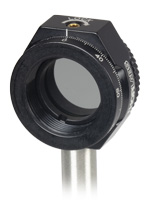 Click to Enlarge
Click to EnlargeLinear Polarizer Mounted into the MRM05(/M)
- Mount Ø1/2" Optics up to 5.8 mm Thick
- Compact Size: 0.81" x 0.78" x 0.44" (20.7 mm x 19.8 mm x 11 mm) [L x W x H]
- Internal SM05 (0.535"-40) Threading for Compatiblity with SM05 Lens Tubes
- One SM05RR Retaining Ring Included
- Post Mountable via 4-40 (M3) Factory-Installed Stud
The MRM05(/M) mount is a lockable, continuous rotation mount for Ø1/2" optics. The mount features full 360° rotation of the mounting carriage, with a marking at every 2° engraved on the circumference of the carriage. The back of the mounting carriage has a knurled edge for easy grip. A setscrew with a 0.05" (1.3 mm) hex is located on top for locking the rotational position. The center aperture is SM05-threaded (0.535"-40) and accepts Ø1/2" (Ø12.7 mm) optics up to 5.8 mm thick. Optics are held in the mount with an included SM05RR retaining ring, which can be adjusted with an SPW603, SPW603L, or SPW801 spanner wrench. These mounts are designed to provide a 10 mm optic axis height when measured from the bottom of the mount to match our Mini-Series Kinematic Mounts.
The MRM05(/M) has a 4-40 (M3 x 0.5) mounting stud for post mounting, making this mount compatible with our Mini-Series Optical Post Assemblies. The mounting stud has a length that is optimal for mounting into posts, but can be removed if desired. The mounting hole has a depth of 0.09" (2.3 mm); caution should be taken in choosing a setscrew with the correct length, as damage to the part can occur.

- Mount Ø1/2" Optics up to 0.23" (5.8 mm) Thick
- Compact: 1.00" x 0.87" x 0.45" (25.4 mm x 22.1 mm x 11.4 mm) [L x W x H]
- Internal SM05 (0.535"-40) Threading for Compatability with SM05 Lens Tubes
- One SM05RR Retaining Ring Included
- Post Mountable via 8-32 (M4) Mounting Tap
With a 1.00" (25.4 mm) height and a 0.45" (11.4 mm) thickness, the RSP05(/M) Ø1/2" rotation mount is an ideal solution for compact optical assemblies. The center aperture accepts Ø1/2" optics up to 0.23" thick (5.8 mm), held in place with a SM05RR retaining ring (one included with RSP05). The knurled edge of the RSP05(/M) and the 360° laser-engraved scale marked at 2° increments allow for precise, repeatable positioning and fine angular adjustment. A convenient top-located setscrew can be tightened with a 1/16" (1.5 mm) hex key or balldriver to secure the rotational position of the mount.

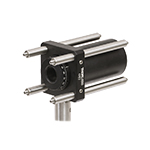
Click to Enlarge
CRM05 Mount in a 30 mm Cage System
- Mount Ø1/2" Optics up to 0.26" (6.5 mm) Thick
- Internal Bore is SM05 (0.535"-40) Threaded for Compatibility with SM05 Lens Tubes
- External SM1 (1.035"-40) Threads for Mounting in SM1 Lens Tubes or 30 mm Cage Cubes
- One SM05RR Retaining Ring Included
The CRM05 is a lockable, continuous-rotation mount for Ø1/2" optics. The mount features full 360° rotation of the front dial face and a setscrew for locking the rotational position into place. External SM1 threads (1.035"-40) allow the mount to be threaded directly onto any internally SM1-threaded device such as SM1 lens tubes or 30 mm cage cubes. The center aperture is SM05-threaded (0.535"-40) and accepts Ø1/2" (Ø12.7 mm) optics up to 0.26" (6.5 mm) thick. Optics are held in the mount with an included SM05RR retaining ring. Two notches along the mount's circumference accommodate the SPW801 adjustable spanner wrench to aid in securing the mount into place.
The knurled edge of the CRM05 and the 360° laser-engraved scale marked at 2° increments allow for precise, repeatable positioning and fine angular adjustment. Four equally spaced witness lines are engraved into the mount's perimeter, ensuring there is always a witness line in a convenient and easily readable position. The mount can be locked into position using the 0.035" hex setscrew on the outer edge.

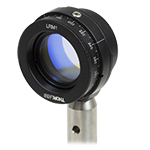
Click to Enlarge
A linear polarizer is mounted in the LRM1 continuous rotation mount. This rotation mount can be post mounted by attaching its external SM1 threads to the LMR1(/M) lens mount.
- Mount Ø1" Optics up to 0.34" (8.6 mm) Thick
- Internal Bore is SM1 (1.035"-40) Threaded for Compatibility with SM1 Lens Tubes
- External SM1 Threads for Mounting in SM1 Lens Tubes or 30 mm Cage Cubes
- One SM1RR Retaining Ring Included
- Not Post Mountable
The LRM1 is a lockable, continuous-rotation mount for Ø1" optics. The mount features full 360° rotation of the front dial face and a setscrew for locking the rotational position into place. External SM1 threads (1.035"-40) allow the mount to be threaded directly onto any internally SM1-threaded device such as SM1 lens tubes or 30 mm cage cubes. Please note that the LRM1 will not fit inside our 30 mm cage systems. The center aperture is also SM1-threaded and accepts Ø1" (Ø25.4 mm) optics up to 0.34” (8.6 mm) thick. Optics are held in the mount with an included SM1RR retaining ring. We recommend using a spanner wrench for the SM1RR retaining ring to help secure the optic into place. In addition, two notches along the mount's circumference accommodate the SPW801 adjustable spanner wrench to aid in securing the mount into place.
The knurled edge of the LRM1 and the 360° laser-engraved scale marked at 2° increments allow for precise, repeatable positioning and fine angular adjustment. Four equally spaced witness lines are engraved into the mount's perimeter, ensuring there is always a witness line in a convenient and easily readable position. The mount can be locked into position using the 8-32 nylon-tipped setscrew on the outer edge. The setscrew can be adjusted using a 5/64" (2.0 mm) hex key or ball driver.

- Mount Ø1" Optics up to 0.47" (11.9 mm) Thick
- Compatible with SM1 Lens Tubes
- One SM1RR Retaining Ring Included
- Post Mountable via an 8-32 (M4) Tapped Hole
The RSP1(/M) Continuous Rotation Mount utilizes two precision bearings for smooth, backlash-free rotation. The aperture is threaded with our internal SM1 threading (1.035"-40) and accepts Ø1" optics up to 0.47" (11.9 mm) thick. Secure the optic with the included SM1RR retaining ring. The SM1 threading also provides a means to connect SM1 lens tubes and other Thorlabs components to the mount.
This mount has a knurled edge for adjusting rotation. A 360° laser-engraved scale marked at 2° increments allows for precise, repeatable positioning and fine angular adjustment. A top-located setscrew can be tightened with a 5/64" (2.0 mm) hex key or balldriver to lock the rotation of the mount.

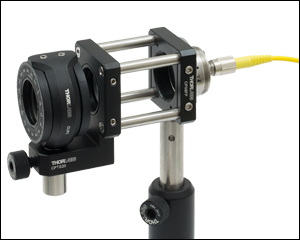
Click to Enlarge
Dual Rotation Mount Integrated in a 30 mm Cage System using CPTS20 Adapter
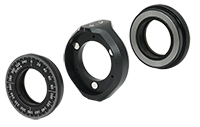
Click to Enlarge
The rotating optic carriages can be easily removed from the main body of the mount.
- Mount Two Ø1" Optics up to 0.25" (6.4 mm) Thick
- Each Optic Carriage Rotates Independently
- Rotating Optic Carriages are Interchangeable for Quick Swapping
- SM1-Threaded Optic Bore in Each Rotating Optic Carriage
- Two SM1RR Retaining Rings Included
- Post Mountable via 8-32 (M4) Tap
The DLM1(/M) Dual Rotation Mount includes two independently rotating carriages (item # DLM1-A) for Ø1" optics that offer 360° of continuous rotation. The optic bore of each carriage features internal SM1 (1.035"-40) threading and can hold an optic up to 0.25" (6.4 mm) thick with the included SM1RR retaining ring. The carriages magnetically attach to the main body of the mount. To remove a carriage from the mount, simply pull the carriage off the main body. Another carriage can then be snapped on in its place. Extra DLM1-A interchangeable rotating carriages are available to allow optics to be swapped out quickly and easily.
Each carriage has a knurled edge for adjusting rotation and a 360° laser-engraved scale marked at 2° increments for precise, repeatable positioning. Two top-located setscrews can be tightened with a 5/64" (2.0 mm) hex key or balldriver to lock the rotation of the optic carriages independently. When the rotation is locked, the double bore on the mount maintains a stable, three-point contact to hold the optic carriage.
The DLM1 mount is designed to put the optic axis 1.00" above the top of the post. The DLM1/M puts the optic axis 25.0 mm above the top of the post. When two optics are mounted, the separation between them is 0.30" (7.6 mm). The dual rotation mount is ideal for creating variable polarizers and attenuators by mounting linear polarizers and wave plates in close proximity without having to align the optic axes of two separate rotation mounts. We do not recommend using this mount with lens tubes, as the torque applied to the optic bore may overcome the magnetic attachment. Optics in SM1-threaded housings can be mounted to the carriage.

This animation shows the movable scale of the Ø2" RSP2D Mount being rotated to align with the fast axis of a wave plate.
- Mount Ø1" Optics up to 0.51" (12.9 mm) Thick
- Dial Face Can Be Rotated Independently of Mounted Optics
- 5 arcmin Vernier Scale
- Compatible with SM1 Lens Tubes
- One SM1RR Retaining Ring Included
- Bottom-Located 8-32 (M4) Tapped Hole for Post Mounting
The RSP1D(/M) Ø1" Continuous Rotation Mount offers the same features as the RSP1(/M) featured above but also incorporates a rotatable dial that can be used, for example, to align a wave plate's optical axis after mounting. Like the RSP1 above, this mount utilizes two precision bearings for smooth, backlash-free rotation. The aperture is threaded with our internal SM1 threading (1.035"-40) and accepts Ø1" optics up to 0.51" (12.9 mm) thick. Secure the optic's position using the included SM1RR retaining ring. The SM1 threading also provides a means to connect SM1 lens tubes and other Thorlabs components to the mount.
This mount has a knurled edge for adjusting rotation and a 360° laser-engraved scale marked at 2° increments to allow for precise, repeatable positioning and fine angular adjustment. The front dial scale can be unlocked and rotated using a 5/64" (2.0 mm) hex key so that the scale can be aligned to the axis of an optic for calibration purposes. A top-located setscrew can be tightened with a 5/64" (2.0 mm) hex key or balldriver to lock the rotation of the mount.

- Holds Ø1" Optics up to 0.50" (12.7 mm) Thick
- Ideal for Round Cylindrical Lenses
- Rotationally Align Optics Within a Lens Tube System
- Post Mountable via 8-32 (M4) Tapped Hole
- Features SM1 Quick Release Adapter on Back of Mount
The CLR1(/M) is a rotation mount designed for use with Ø1" round cylindrical lenses and other rotationally sensitive optics within a lens tube system. As round cylindrical lenses only focus or expand light in one dimension, they are not easily aligned within a standard lens mount or lens tube. This rotation mount can be sandwiched between two lens tubes to provide rotation of the mounted optic without disturbing the attached lens tubes.
The back side of this mount utilizes an SM1 (1.035"-40) quick release adapter, which allows the mount to be quickly disconnected and reconnected to a lens tube setup. Please note that this adapter must be removed while inserting an optic in the mount, but once the optic is mounted, the adapter can be reattached. A convenient top-located setscrew can be tightened with a 0.05" (1.3 mm) hex key or balldriver to secure the rotational position of the mount.

- Directly Mounts Ø1" Optics up to 0.50" (12.7 mm) Thick
- Scale can be Rotated Independently of Mounted Optic for Alignment
- Switch Between Continuous and Discrete Rotation
- RSP1X15(/M): Discrete Rotation in 15° Increments
- RSP1X225(/M): Discrete Rotation in 22.5° Increments
- 5 arcmin Vernier Scale is Ideal for Polarization Optics
- One SM1RR Retaining Ring Included
- Post Mountable via 8-32 (M4) Tap
The RSP1X15(/M) and RSP1X225(/M) rotation mounts for Ø1" optics feature both continuous 360° rotation and stepped rotation in increments of 15° for the RSP1X15(/M) or 22.5° for the RSP1X225(/M). The top of each mount has a setscrew that, when loosened with a 5/64" (2.0 mm) hex key or balldriver, allows for smooth, continuous, 360° rotation. Tightening the setscrew engages a detent mechanism that forces the mount to rotate in discrete increments. The mounted optic is retained in the central SM1-threaded (1.035"-40) bore using the included SM1RR retaining ring.
In addition, the engraved scale can be unlocked and rotated independently of the optic so that the markings can be aligned with respect to the mounted optic. For example, the zero of the engraved scale can be aligned with the fast axis of a wave plate or the polarization axis of a linear polarizer. To help with the alignment, an engraved arrow extends the zero mark all the way to the outside edge of the SM1-threaded bore used to mount the optic. This animation to the right details the operation of the RSP1X15.

- Mount Ø2" Optics up to 0.51" (13 mm) Thick
- Compatible with SM2 Lens Tubes
- One SM2RR Retaining Ring Included
- Bottom-Located 8-32 (M4) Tapped Hole for Post Mounting
The RSP2(/M) Continuous Rotation Mount utilizes two precision bearings for smooth rotation. The aperture features internal SM2 (2.035"-40) threading and accepts Ø2" optics up to 0.51" (13 mm) thick as well as any SM2-threaded component. Secure the optic using the included SM2RR retaining ring.
The mount has a knurled edge for rotation. A 360° laser-engraved scale marked at 2° increments allows for precise, repeatable positioning and fine angular adjustment. A top-located setscrew can be tightened with a 5/64" (2.0 mm) hex key or balldriver to lock the rotation of the mount.

This animation shows the movable scale of the RSP2D Mount being rotated to align with the fast axis of a wave plate.
- Mount Ø2" Optics up to 0.54" (13.7 mm) Thick
- Dial Face can be Rotated Independently of Mounted Optics
- 5 arcmin Vernier Scale
- Compatible with SM2 Lens Tubes
- One SM2RR Retaining Ring Included
- Bottom-Located 8-32 (M4) Tapped Hole for Post Mounting
The RSP2D(/M) Ø2" Continuous Rotation Mount offers the same features as the RSP2 featured above but also incorporates a rotatable dial that can be used, for example, to align a wave plate's optical axis after mounting. Like the RSP2(/M) above, this mount utilizes two precision bearings for smooth, backlash-free rotation. The aperture is threaded with our internal SM2 threading (2.035"-40) and accepts Ø2" optics up to 0.54" (13.7 mm) thick. Secure the optic's position using the included SM2RR retaining ring. The SM2 threading also provides a means to connect SM2 lens tubes and other Thorlabs components to the mount.
This mount has a 360° laser-engraved scale marked at 2° increments to allow for precise, repeatable positioning and fine angular adjustment. The front dial scale can be unlocked and rotated using a 5/64" (2.0 mm) hex key so that the scale can be aligned to the axis of an optic for calibration purposes. A top-located setscrew can be tightened with a 5/64" (2.0 mm) hex key or balldriver to lock the rotation of the mount.
 Products Home
Products Home














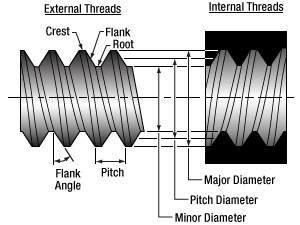

 Zoom
Zoom
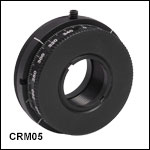
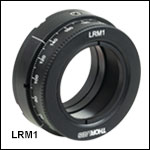
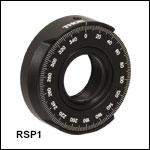
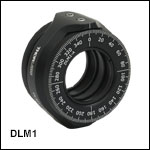
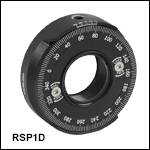
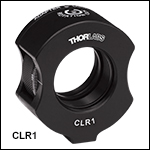
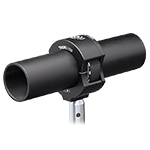
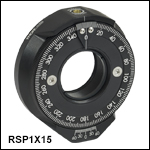
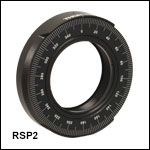
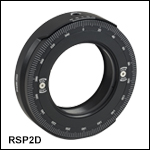
 Manual Rotation Mounts
Manual Rotation Mounts